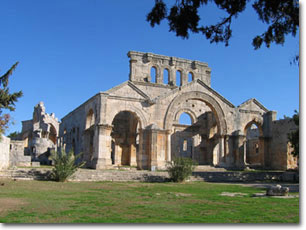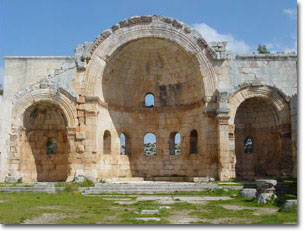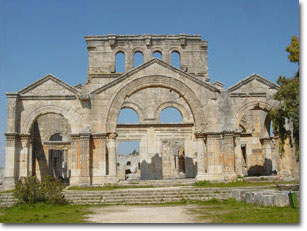|
Home > Explore Syria > St. Simeon Church |
St. Simeon Church
|
|
|
St. Simeon Church (Samaan Citadel):
As all roads in Northern Syria lead to Qalaat Semaan, so does the history of Syrian architecture  lead up to the building of the great church and monastery which were erected at the foot of St Simeon's pillar. lead up to the building of the great church and monastery which were erected at the foot of St Simeon's pillar.
Situated 60 Km from Aleppo is the well-preserved Church of St. Simeon. This beautiful church was built in honor of St. Simeon the Stylite who lived here atop a column for 37 years. This church became famous and was visited by pilgrims from all around the area.
St. Simeon:
St. Simeon was born around 386 in a village in the Amanus Mountains. His purpose of standing atop a 12 to 18 meter column, which was nearly 2 meters in diameter, was to get closer to God. People from all around came to visit him and hear him preach twice a day. His death in 459 however did not stop the visitors who went on to becoming pilgrims and the Martyrion was built in his honor (although his body was taken by a few Byzantine soldiers to Antioch and later to Constantinople).
Unlike the later cathedrals of medieval Europe, the great church was conceived and executed more or less as a single project over a short space of time. The cruciform comprising four separate basilica buildings was probably constructed shortly after the death of the saint. The cause of St Simeon was tolerated and eventually promoted by the imperial authorities. It was built in 473 due to the crowds of pilgrims visiting and praying at St. Simeon's column.
Syria Samaan Citedel The ambitious plan of the complex reflects several architectural styles. The basic concept of the three-aisled basilica already had a long tradition going back to Roman times. The first to build was the main basilica and the baptistery itself, then the monastery and the annexes to the baptistery, and finally, the other parts of the complex such as the monumental arch on the Via Sacra.
The best vestiges seen in Deir Semaan are the monumental arch that is at the beginning of the via sacra which leads to the cathedral on the hill. There are two monasteries, a bazaar, a few small dwellings, and a tomb chapel.
The complex was arranged in several grouped buildings:
The Four-Basilica Church:
The cruciform church is very well preserved and is very beautiful in the spring with all the freshly bloomed flowers. St. Simeon's column is still evident as a 2 meter high boulder in the center of the courtyard. The octagonal courtyard is surrounded by four basilicas in the form of a crucifix and is called the four-basilica church. The east basilica is slightly larger than the others; it was the most important and held all the major ceremonies.
The U-shaped Monastery:
Adjacent to the south wall of the eastern basilica is the chapel and the monastery. Deir Semaan (Simeon Monastery) first had the name of Telanissos and was founded to capitalize on the two fertile plains that surrounded it. In the 5th century AD, the community built a monastery there and in 412 St. Simeon came to join it. He later left the community to live alone in the hill above it.
The Baptistery:
Opposite the southern basilica along the sacred road called the "Via Sacra" is the baptistery, which was built a little after the main church but is an important part of the pilgrimage complex. Described as "one of the finest remnants of Christian architecture in the whole of Syria", it was built in two phases - the baptistery itself first; the associated small basilica later. The octagonal drum which externally tops the square base of the building was once crowded by a wooden roof shaped either like a cone or a dome. The inner octagon was enclosed in a rectangular outer  building. At the east end of the chamber is a semi-circular absidiola which includes a curious channel with steps leading down to it. building. At the east end of the chamber is a semi-circular absidiola which includes a curious channel with steps leading down to it.
Annexes to the Baptistery:
To the west of the baptistery is the processional route that leads towards Deir Semaan. At the beginning of this route is the monumental arch that leads from the monastery to the baptistery. |


